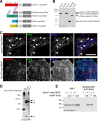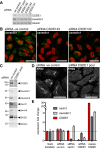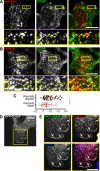BioID identifies proteins involved in the cell biology of caveolae
- PMID: 30589899
- PMCID: PMC6307745
- DOI: 10.1371/journal.pone.0209856
BioID identifies proteins involved in the cell biology of caveolae
Abstract
The mechanisms controlling the abundance and sub-cellular distribution of caveolae are not well described. A first step towards determining such mechanisms would be identification of relevant proteins that interact with known components of caveolae. Here, we applied proximity biotinylation (BioID) to identify a list of proteins that may interact with the caveolar protein cavin1. Screening of these candidates using siRNA to reduce their expression revealed that one of them, CSDE1, regulates the levels of mRNAs and protein expression for multiple components of caveolae. A second candidate, CD2AP, co-precipitated with cavin1. Caveolar proteins were observed in characteristic and previously un-described linear arrays adjacent to cell-cell junctions in both MDCK cells, and in HeLa cells overexpressing an active form of the small GTPase Rac1. CD2AP was required for the recruitment of caveolar proteins to these linear arrays. We conclude that BioID will be useful in identification of new proteins involved in the cell biology of caveolae, and that interaction between CD2AP and cavin1 may have an important role in regulating the sub-cellular distribution of caveolae.
Conflict of interest statement
The authors have declared that no competing interests exist.
Figures







Similar articles
-
EHD2 regulates caveolar dynamics via ATP-driven targeting and oligomerization.Mol Biol Cell. 2012 Apr;23(7):1316-29. doi: 10.1091/mbc.E11-09-0787. Epub 2012 Feb 9. Mol Biol Cell. 2012. PMID: 22323287 Free PMC article.
-
A phosphoinositide-binding cluster in cavin1 acts as a molecular sensor for cavin1 degradation.Mol Biol Cell. 2015 Oct 15;26(20):3561-9. doi: 10.1091/mbc.E15-06-0359. Epub 2015 Aug 12. Mol Biol Cell. 2015. PMID: 26269585 Free PMC article.
-
Rac1 recruits the adapter protein CMS/CD2AP to cell-cell contacts.J Biol Chem. 2010 Jun 25;285(26):20137-46. doi: 10.1074/jbc.M109.099481. Epub 2010 Apr 19. J Biol Chem. 2010. PMID: 20404345 Free PMC article.
-
The role of membrane-shaping BAR domain proteins in caveolar invagination: from mechanistic insights to pathophysiological consequences.Biochem Soc Trans. 2020 Feb 28;48(1):137-146. doi: 10.1042/BST20190377. Biochem Soc Trans. 2020. PMID: 32104881 Review.
-
Possible regulation of caveolar endocytosis and flattening by phosphorylation of F-BAR domain protein PACSIN2/Syndapin II.Bioarchitecture. 2015;5(5-6):70-7. doi: 10.1080/19490992.2015.1128604. Bioarchitecture. 2015. PMID: 26745030 Free PMC article. Review.
Cited by
-
Characterizing host-microbe interactions with bacterial effector proteins using proximity-dependent biotin identification (BioID).Commun Biol. 2025 Apr 10;8(1):597. doi: 10.1038/s42003-025-07950-y. Commun Biol. 2025. PMID: 40210669 Free PMC article. Review.
-
Caveolae Mechanotransduction at the Interface between Cytoskeleton and Extracellular Matrix.Cells. 2023 Mar 20;12(6):942. doi: 10.3390/cells12060942. Cells. 2023. PMID: 36980283 Free PMC article. Review.
-
CD2AP at the junction of nephropathy and Alzheimer's disease.Mol Neurodegener. 2025 Jun 4;20(1):63. doi: 10.1186/s13024-025-00852-x. Mol Neurodegener. 2025. PMID: 40462155 Free PMC article. Review.
-
Time-resolved proximity proteomics uncovers a membrane tension-sensitive caveolin-1 interactome at the rear of migrating cells.Elife. 2024 Sep 24;13:e85601. doi: 10.7554/eLife.85601. Elife. 2024. PMID: 39315773 Free PMC article.
References
Publication types
MeSH terms
Substances
Grants and funding
LinkOut - more resources
Full Text Sources
Molecular Biology Databases
Research Materials
Miscellaneous

